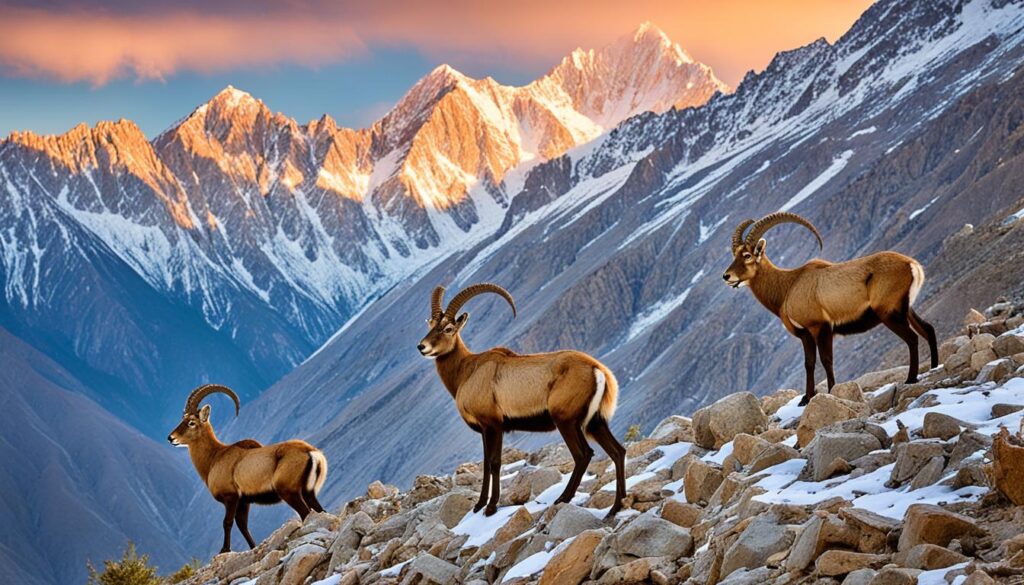
With its diverse landscapes, from the soaring peaks of the Himalayas to the vast deserts of Thar, Pakistan boasts a remarkable array of wildlife. From majestic big cats to vibrant bird species and elusive mountain goats, the country’s animal kingdom is truly awe-inspiring.
In this article, we will delve into the fascinating world of animals in Pakistan and explore the efforts being made to protect and conserve its rich biodiversity. Join us as we journey through the unique habitats and wildlife sanctuaries, uncovering the wonders of Pakistan’s indigenous fauna and the intricacies of its conservation efforts.
Key Takeaways:
- Pakistan is home to over 1,000 species of animals.
- The country’s diverse landscapes support a rich variety of wildlife.
- Efforts are being made to protect and conserve Pakistan’s biodiversity.
- Habitats and indigenous fauna play a crucial role in the country’s ecosystem.
- Wildlife sanctuaries and conservation areas are integral to preserving endangered species.
Wildlife Conservation Efforts
Pakistan is home to a diverse range of wildlife, with various species inhabiting its rich and varied ecosystems. However, these animals face numerous threats that are pushing them towards the brink of extinction. In response, the country has implemented robust wildlife conservation efforts to protect endangered species and preserve its unique biodiversity.
The conservation initiatives in Pakistan are multifaceted, encompassing both government-led programs and the work of non-profit organizations dedicated to wildlife preservation. These efforts aim to safeguard the delicate balance of nature and ensure the long-term survival of animal species.
One of the key components of wildlife conservation in Pakistan is the identification and protection of endangered species. The country has recognized the importance of these rare and vulnerable animals and has taken measures to ensure their survival. By providing protected habitats and implementing conservation strategies, Pakistan strives to maintain the equilibrium of its ecosystems.
Biodiversity in Pakistan
Pakistan is known for its incredible biodiversity, boasting a wide array of animal species that are unique to the region. From the majestic snow leopard in the mountains to the elusive Indus river dolphin in the waterways, the country is a treasure trove of indigenous fauna.
Preserving this biodiversity is crucial not only for the animals themselves but also for the overall health and resilience of ecosystems. Recognizing this, Pakistan has established protected areas such as national parks and wildlife sanctuaries to provide safe havens for wildlife and promote the conservation of their habitats.
Animal Protection Laws
Pakistan has also implemented strong animal protection laws to safeguard its wildlife. These laws prohibit activities such as poaching, trafficking, and illegal trade of endangered species, ensuring that offenders are held accountable for their actions.
Additionally, these laws empower authorities to impose penalties on individuals or organizations found guilty of violating animal protection regulations. By enforcing these laws, Pakistan aims to deter wildlife-related crimes and promote responsible behavior towards animals.
| Conservation Initiatives | Organizations | Animal Protection Laws |
|---|---|---|
| Efforts to protect wildlife habitats and create conservation programs | World Wildlife Fund (WWF) Pakistan | Laws prohibiting poaching, trafficking, and illegal trade of endangered species |
| Conservation breeding programs for endangered species | Society for Conservation and Protection of Environment (SCOPE) | Penalties for offenders of animal protection regulations |
| Awareness campaigns and education programs about wildlife conservation | National Council for Conservation of Wildlife (NCCW) | Legal frameworks for the protection of wildlife habitats |
These animal protection laws, combined with the efforts of various organizations and individuals, contribute to the overall conservation of wildlife in Pakistan. Together, they strive to create a future where the country’s unique biodiversity thrives and endangered species are protected for generations to come.
Animal Habitats and Indigenous Fauna
Pakistan is blessed with a diverse range of animal habitats, each contributing to the thriving indigenous fauna found within its borders. From the majestic mountains of the Himalayas to the sprawling deserts of Thar, the country boasts a variety of ecosystems that support a rich and unique array of wildlife.
The northern regions of Pakistan, including Gilgit-Baltistan and Khyber Pakhtunkhwa, are home to the lofty peaks of the Karakoram and Hindu Kush mountain ranges. These high-altitude habitats provide shelter to iconic species such as the Snow Leopard, Himalayan Ibex, and Marco Polo Sheep. The cold, harsh climates of these regions have shaped the evolutionary adaptations of these animals, allowing them to thrive in extreme conditions.
The lush forests of Pakistan, such as the Chitral Valley and the Margalla Hills, harbor a diverse range of flora and fauna. These habitats are a haven for species like the Indus River Dolphin, Asiatic Black Bear, and various species of deer. The dense vegetation provides ample food and shelter, making these forests ideal habitats for a wide range of indigenous wildlife.
In the arid regions of Balochistan and Sindh, where temperatures soar and rainfall is scarce, unique desert ecosystems flourish. The vast expanse of the Thar Desert is home to the Chinkara, Houbara Bustard, and the critically endangered Indus River Dolphin. These animals have adapted to the harsh desert conditions, relying on specialized features and behaviors to survive in the arid landscapes.
Coastal areas, such as the Arabian Sea coastline and the Indus Delta, offer a completely different set of habitats. Mangrove forests play a critical role in these areas, providing nurseries for fish and protecting against coastal erosion. The Indus River Delta is a prime habitat for the endangered Indian Freshwater Crocodile, also known as the Gharial, showcasing the incredible biodiversity supported by these unique coastal habitats.
The table below summarizes some of the key animal habitats and their indigenous fauna in Pakistan:
| Habitat | Indigenous Fauna |
|---|---|
| Mountainous Regions | Snow Leopard, Himalayan Ibex, Marco Polo Sheep |
| Forests | Indus River Dolphin, Asiatic Black Bear, Various Deer Species |
| Deserts | Chinkara, Houbara Bustard, Indus River Dolphin |
| Coastal Areas | Indian Freshwater Crocodile, Various Fish Species |
These habitats and the diverse range of indigenous fauna they support are not only significant from an ecological standpoint but also contribute to the cultural heritage of Pakistan. It is essential to protect and conserve these habitats to ensure the survival of the unique wildlife that call them home.

Wildlife Sanctuaries and Conservation Areas
In Pakistan, there are several wildlife sanctuaries and conservation areas that play a crucial role in preserving the country’s biodiversity and protecting endangered species. These protected areas provide a safe haven for a wide range of flora and fauna, allowing them to thrive and ensuring their long-term survival.
One notable wildlife sanctuary in Pakistan is the Lal Suhanra National Park, located in Bahawalpur. It spans over 153,000 acres and is home to various species of mammals, birds, and reptiles. The park’s diverse ecosystems, including wetlands, grasslands, and sand dunes, support a rich array of wildlife.

Mangrove ecosystems of the Indus Delta
Another important conservation area is the Indus Delta, which boasts extensive mangrove ecosystems. These mangroves serve as a natural habitat for numerous species, including the endangered Indus River dolphin, green turtles, and migratory birds.
Located in Punjab province, the Taunsa Barrage Wildlife Sanctuary is yet another sanctuary that deserves mention. Spanning over 99,000 acres, it is particularly renowned for its diverse bird population, making it a popular destination for birdwatchers and nature enthusiasts.
These and many other wildlife sanctuaries and conservation areas in Pakistan contribute significantly to the preservation of biodiversity and the protection of endangered species.
Moreover, animal research conducted within these sanctuaries helps foster a greater understanding of the local ecosystems and the species that inhabit them. Researchers study various aspects of animal behavior, population dynamics, and interactions with the environment, providing valuable insights for conservation efforts.
It is through these research initiatives that scientists can develop effective strategies and management plans to ensure the long-term sustainability of Pakistan’s unique wildlife.
Conservation Efforts
Besides providing a safe environment for wildlife, these sanctuaries also engage in conservation efforts such as habitat restoration, reforestation, and anti-poaching measures. Collaborations with local communities and educational programs further promote the importance of biodiversity conservation.
In conclusion, Pakistan’s wildlife sanctuaries and conservation areas serve as crucial havens for protecting biodiversity and preserving endangered species. Through ongoing research and conservation efforts, these areas play a pivotal role in safeguarding the nation’s natural heritage for generations to come.
Conclusion
In conclusion, the diverse and exotic animals found in Pakistan are a testament to the country’s rich biodiversity. From the majestic snow leopards in the Himalayas to the vibrant marine life along the coast, Pakistan is home to a wide range of unique species.
It is imperative that we prioritize wildlife conservation and take steps to protect these precious creatures and their habitats. Ongoing efforts by various organizations, coupled with the implementation of animal protection laws, are crucial in ensuring the survival of endangered species and the preservation of Pakistan’s fauna.
By preserving the animals and biodiversity in Pakistan, we not only safeguard the country’s natural heritage but also contribute to the overall ecological balance. The fragile ecosystems in Pakistan play a vital role in maintaining the health of our planet, and it is our responsibility to take action and raise awareness about their importance.
Continued efforts in wildlife conservation, supported by scientific research and public engagement, are essential for the long-term sustainability of Pakistan’s animals and ecosystems. Let us join hands in protecting and cherishing the natural wonders that make Pakistan truly unique.
